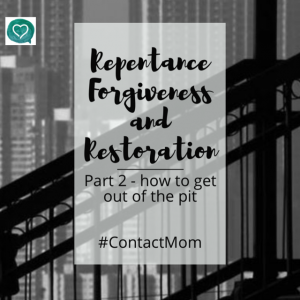In my first blog, I defined the process of repentance, forgiveness, and restoration. Now I’d like to explain how we taught this process to our children.
What you will need:
1 black trash bag
1 white trash bag
Red construction paper
Scissors
1 Sharpie-type marker
Directions:
Fold each trash bag into a flat square and place a few feet apart on the floor.
Trace your foot on the red paper and cut out 3 footprints. Write on each footprint one word:
- Repentance 2. Forgiveness 3. Restoration
Place these on the floor in order between the 2 trash bags. Everything should be close enough to follow the foot path easily from the black to the white trash bag.
We taught our children this verse: 1 John 1:9 “If we confess our sins, He [God] is faithful and just to forgive us our sins and to cleanse us from all unrighteousness.”
The process:
- The black trash bag represents us in our sinful state. (This somehow got labeled “The Pit” in our house.) It is where we start when there has been an offense against another family member. We had the ‘offender’ stand on the black trash bag facing away from the footsteps. The ‘offended’ party was nearby.
- Step 1: Repentance
When the offender was ready, he had to physically turn around 180° to take the first step of repentance. This was an outward demonstration of what we were encouraging in the heart of our children. Since the verse says to “confess our sins”, we taught our children to verbally confess the offense. The definition of the word confess in this context means “to agree with, to speak the same thing.” The offender must admit to his wrong action or attitude and “speak the same thing” as God about his offense. We had him complete the phrase “I agree I was wrong for…” and name the wrong action, i.e. yelling at my brother, not doing what I was told, telling Mom “No” etc.
- Step 2: Forgiveness
Next we had the offender ask the offended for forgiveness. We taught them to use the phrase, “Will you please forgive me for…” and we had them label the offense, i.e. for being angry and unkind, disobedient, rebellious, etc. This helped them to get to the root of the sinful attitudes that led to the wrong action. The offended party at this point would affirm his forgiveness. As the parent, I would assure my child that just like the Lord is “faithful and just to forgive us”, I always stood ready to forgive him. He only needs to reach out to accept it.
- Step 3: Restoration
Sometimes there is more needed than just words and hugs. This step is added in cases where restitution might be needed to fully restore the relationship. In such situations we had the offending child ask the offended, “What can I do to make this right?” A child might do chores to replace a broken item, give back extra for something stolen, or go back to speak truth to someone to whom he lied. Once the right course of action has been decided, the matter can be considered closed. The child should follow through in a timely manner. If restitution is not required this footstep can be placed in the white square.
- The White Trash Bag is the end of the process. All is forgiven and the sin is cleansed and buried to be remembered no more. We taught and modeled for our kids that forgiveness meant that we would not bring up the offense again or let it stand in the way of our relationship.
We would take our kids through this process in a time of non-conflict, having them role play being the offender and the offended. We would leave it all set up for a week or so and, if appropriate, we would use it as conflicts came up. It gave a concrete picture of these concepts that we could refer to again and again long after it was all put away.
We kept it very simple for our youngest children. Even toddlers can learn the process and phrases, although they won’t understand the relational component of repentance until they are closer to 4- or 5-years-old. We also did not require our 3-year-olds to be very specific in confession but often helped to supply the words to help them understand how they disobeyed. Once our children were trained in the process and a little older, we could begin to require more from them as their understanding increased. We would teach from God’s Word and pray with and over our children during this time of reconciliation. We also modeled these steps when we had our own sins and failures to confess.
So why are the footsteps red?
This tool was originally designed to present the Gospel to children. We are all born in “The Pit,” i.e. “dead in trespasses and sins.” (Ephesians 2:1) The power to take the steps to repent and to receive forgiveness and salvation is through the blood of Christ shed for us on the cross. The red footsteps remind us it is only by His blood, His atoning work, that we are able to step from darkness (The Pit) into His marvelous light – fully restored to a right relationship with Him.
“Therefore as you have received Christ Jesus the Lord, so walk in Him,” Colossians 2:6
Repentance and forgiveness are the practical steps to both receive Christ Jesus as Savior and walk with Him each day, restoring and maintaining an abiding relationship with the Lord and our fellow man. It is the duty of every Christian parent to teach these things to our children, as well as practice them ourselves. In so doing, we are a beautiful illustration of the Gospel to the world.
*This is my personal adaptation of this teaching tool I first learned years ago from Carla Link.





Leave a Reply